英语教学法小组ppt
合集下载
英语教学法 PPT Unit+2+CLT
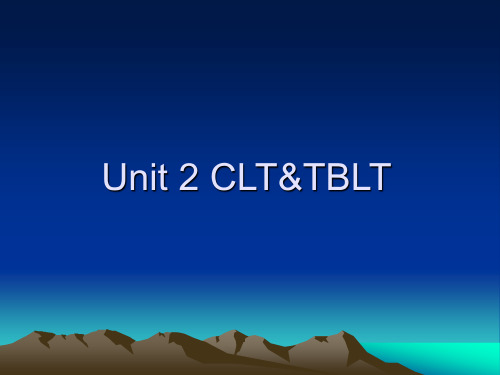
Designing tasks
• When designing a task, think about the following questions: • 1. what is the purpose of the task? 2.what is the content of the task? 3. how is the task to be carried out? 4. In what situation is the task to be carried out? • Specific steps: • 1. take into account the students’ needs, interests, and abilities. • 2.Brainstorm possible tasks • 3.evaluate the list • 4. choose the language items • 5.preparing materials
Classification of communicative activities
• Functional communicative activities: 1)indentifying 2)discovering 3)following 4)reconstructing 5)pooling • Social interactional activities: 1)roleplaying 2)simulation activity 3)discussion 4) debate 5)interview 6) improvisation
Exercise, exercise-task and task exerciseExercise -focus on language items
英语课堂教学活动 ppt课件
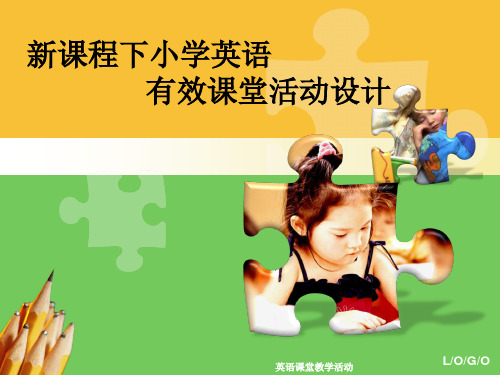
教学活动
• 如何创新
• 细化(具体实施) • 调整
活动的有效性
课堂教学需思考三点
英语课堂教学活动
让学生学会什么本领?
教学目标
给学生做什么事?
教学活动
学生从你的活动中获得了什么? 活动的有效性
年级培养目标
整册书教学目标 单元教学目标
课时教学目标
英语课堂教学活动
三 维 目 标
新授课 复习课 拓展课 故事课
英语课堂教学活动
•• Put yourself at the position of the students
•• Put the students to experience the learning process
•• Put the emphasis on students’ practice
展(学科成绩;人的发展)
英语课堂教学活动
• 课堂活动设计的原则
课堂活动设计原则
英语课堂教学活动
1
目的性
活动与教学不能分离
所有的活动都应该为教学服务,为学生 更好地完成学习任务服务,不能为活动 而活动,更不能为了活动加大教学难度。
• 英语课堂是学生学习英语的主阵地。
感受语言 领悟语言
理解语言 运用语言
呈现知识
观察学生的 学习过程
判断学生的 学习效果
课堂活动分类
按活动内容分
交际活动
语言结构训练活动
词 汇 句型 语音训练活动
英语课堂教学活动
按活动形式分 真实情景活动 模拟情景活动 角色扮演活动 游戏活动
对课堂活动的理解误区
英语课堂教学活动
教学目标-案例1 (初稿)
(一)知识技能目标 1.学生能掌握astronaut, detective,
英语教学法教程(课堂PPT)

对语言教学本质的理解及其对教学实践的影响
9
Views on Lanuage
• The Structural View (结构主义) • The functional View(功能主义) • The interactional View(相互作用理论或交
互理论)
10
The Structural View
23
The Cognitive Theory
• Chomsky
– Language is not a form of behaviour, it is a complicated rule-based system.( Language is a rule-governed)
– There are a finite number of grammatical rules in the system and with knowledge of these rules an infinite number of sentences can be produced (language is generative)
• 语言的本质是由结构上相互联系的单位组 成的、用来表达一定意义的结构系统。
11
• The system of language=
•
the system of sound +
•
the system of words +
•
they system of grammar +
12
•
sente习的目标被认为是掌握该系统中各 种成分,即音位、语法单位、词汇等)
14
Impact on language teaching
• Audiolingual approach (听说法) • Total Physical Method (全身反应法) • The Silent Way (沉默法)
9
Views on Lanuage
• The Structural View (结构主义) • The functional View(功能主义) • The interactional View(相互作用理论或交
互理论)
10
The Structural View
23
The Cognitive Theory
• Chomsky
– Language is not a form of behaviour, it is a complicated rule-based system.( Language is a rule-governed)
– There are a finite number of grammatical rules in the system and with knowledge of these rules an infinite number of sentences can be produced (language is generative)
• 语言的本质是由结构上相互联系的单位组 成的、用来表达一定意义的结构系统。
11
• The system of language=
•
the system of sound +
•
the system of words +
•
they system of grammar +
12
•
sente习的目标被认为是掌握该系统中各 种成分,即音位、语法单位、词汇等)
14
Impact on language teaching
• Audiolingual approach (听说法) • Total Physical Method (全身反应法) • The Silent Way (沉默法)
英语教学方法ppt课件
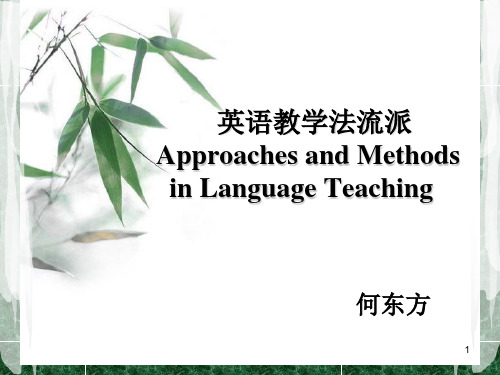
英语教学法流派 Approaches and Methods in Language Teaching
何东方
1
Review The Grammar-Translation Method
Definition: It means to translate from mother tongue to target language.That is to say,the method teaches foreign language with grammar explaination and translation exercise.
电子技术为核心的知识、技术技术密集型产业发展很快。 ➢ 听说法是20世纪40年代末在美国形成的外语教学法。二战期间,美国军
队进驻很多国家,军人急需掌握外语,特别是通过军队外语培训等教学 活动,创立了听说法。 ➢ 20世纪60年代末70年代初,随着另一门新兴学科社会语言学的诞生,社 会语言学家提出了“交际能力”的概念,在外语教学界引起了强烈的反 响,交际教学法学派随即迅速崛起。 ➢ 在交际法的带动下,20世纪70年代还兴起了人文主义教学法,主要包括 沉默法(the silent way)、提示法(suggestopedia)、社区式语言学习 (community language learning)和全身反应教学法(the total physical response method)等新型的外语教学法。这些教学法的共同特点是强调 学生是教学的主体。除了分析学生的需要和学习过程外,还注意学生学 习外语的心理特点,努力创造条件,排除学生学习外语时的心理障碍。 4
2
外语教学简史
一、500年前,
➢ 15世纪以前,在西欧、拉丁语处于主流地位,不仅用于日常口语
何东方
1
Review The Grammar-Translation Method
Definition: It means to translate from mother tongue to target language.That is to say,the method teaches foreign language with grammar explaination and translation exercise.
电子技术为核心的知识、技术技术密集型产业发展很快。 ➢ 听说法是20世纪40年代末在美国形成的外语教学法。二战期间,美国军
队进驻很多国家,军人急需掌握外语,特别是通过军队外语培训等教学 活动,创立了听说法。 ➢ 20世纪60年代末70年代初,随着另一门新兴学科社会语言学的诞生,社 会语言学家提出了“交际能力”的概念,在外语教学界引起了强烈的反 响,交际教学法学派随即迅速崛起。 ➢ 在交际法的带动下,20世纪70年代还兴起了人文主义教学法,主要包括 沉默法(the silent way)、提示法(suggestopedia)、社区式语言学习 (community language learning)和全身反应教学法(the total physical response method)等新型的外语教学法。这些教学法的共同特点是强调 学生是教学的主体。除了分析学生的需要和学习过程外,还注意学生学 习外语的心理特点,努力创造条件,排除学生学习外语时的心理障碍。 4
2
外语教学简史
一、500年前,
➢ 15世纪以前,在西欧、拉丁语处于主流地位,不仅用于日常口语
英语教学法流派Approaches and Methods in Language Teaching.ppt
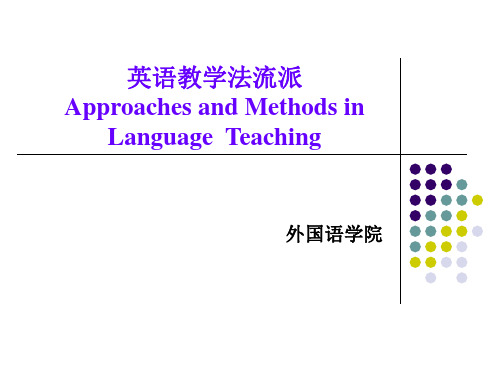
4. 教授新课文:教师出示一幅表述课文内容的图画。 一边讲解图画,一边检查学生是否理解。讲解后根据 图画提问,要求学生回答。
5. 学生两人一组根据图画提问与回答。全班唱一首英 语歌结束一课。
Advantage
Ss’ correct pronunciation and better oral skills are developed because no native language is used.
2. Only everyday vocabulary and sentences were taught.
3. Grammar was taught inductively.
4. New teaching points were introduced orally.
5. Concrete vocabulary is taught through demonstration, objects, and pictures. Abstract vocabulary is taught by association of ideas.
Until the 19th century, grammar –translation method became widely approved and used in the whole world.
1. Understanding and memorization of complicated grammatical rules of languages were regarded as important means of development mentality.
Background
In the late 19th century in Europe, for economic development, the communication among nations became more frequent. Foreign language learning was highly demanded. Oral communication became the main goal of foreign language teaching.
5. 学生两人一组根据图画提问与回答。全班唱一首英 语歌结束一课。
Advantage
Ss’ correct pronunciation and better oral skills are developed because no native language is used.
2. Only everyday vocabulary and sentences were taught.
3. Grammar was taught inductively.
4. New teaching points were introduced orally.
5. Concrete vocabulary is taught through demonstration, objects, and pictures. Abstract vocabulary is taught by association of ideas.
Until the 19th century, grammar –translation method became widely approved and used in the whole world.
1. Understanding and memorization of complicated grammatical rules of languages were regarded as important means of development mentality.
Background
In the late 19th century in Europe, for economic development, the communication among nations became more frequent. Foreign language learning was highly demanded. Oral communication became the main goal of foreign language teaching.
初中英语教学设计ppt课件

能力目标 情。 2.能够正确运用What, How long引
导的特殊疑问句 3.能够用自己在本单元 中所学的语言内容进行实际对话与应用。
Ability Aim
Emotion Aim
情感目标
1.培养学生能够科学合理地安排假期计 划的意识,从而养成良好的学习习惯 2.能在描述自己的计划时激起学生更加 热爱祖国的美好河山,贡献自己的力量
Activity : free talk 3’鼓励学生用之前学过的现在进行时自由谈论 (复习现 在进行时表示正在发生的动作或存在的状态)
guessing1’ 老师出示一些动作图片,让学生来猜
Brain storm 2’(Collect the names of activities which said by students )
Purpose: 以竞赛的形式复习所学动词词组,巩固落实所学知识;同时以 旧带新,导入新课的教学。
Step 2 presentation 10’
Activity : Watch a video: Let’s travel. 3’通过卡通歌曲引入新课教学,让学生 对现在进行时表将来有初步意识,便于其后的教学
.
4
1.词汇:
教学目标
wash ,drink ,tomorrow ,miss ,shop ,wish ,use
Study ,young ,delicious ,house,等,
知 2. 语法:①现在进行时表示将来的用法 识 ②用what, when, where, who , how等对句 目 中的事件、时间、地点、人物等提问。
.
12
What are the boys doing?
They are boating on the river.
导的特殊疑问句 3.能够用自己在本单元 中所学的语言内容进行实际对话与应用。
Ability Aim
Emotion Aim
情感目标
1.培养学生能够科学合理地安排假期计 划的意识,从而养成良好的学习习惯 2.能在描述自己的计划时激起学生更加 热爱祖国的美好河山,贡献自己的力量
Activity : free talk 3’鼓励学生用之前学过的现在进行时自由谈论 (复习现 在进行时表示正在发生的动作或存在的状态)
guessing1’ 老师出示一些动作图片,让学生来猜
Brain storm 2’(Collect the names of activities which said by students )
Purpose: 以竞赛的形式复习所学动词词组,巩固落实所学知识;同时以 旧带新,导入新课的教学。
Step 2 presentation 10’
Activity : Watch a video: Let’s travel. 3’通过卡通歌曲引入新课教学,让学生 对现在进行时表将来有初步意识,便于其后的教学
.
4
1.词汇:
教学目标
wash ,drink ,tomorrow ,miss ,shop ,wish ,use
Study ,young ,delicious ,house,等,
知 2. 语法:①现在进行时表示将来的用法 识 ②用what, when, where, who , how等对句 目 中的事件、时间、地点、人物等提问。
.
12
What are the boys doing?
They are boating on the river.
《小学英语教学法》课件

口语教学的重要性
口语教学
口语教学的基本原则
口语教学的方法与技巧
口语教学的实践应用
阅读与写作教学
阅读教学的目的和重要性 阅读策略和技巧 写作教学的目标和要求 写作技巧和训练方法
教学目标:明确课程目标,确定教 学内容和教学方法
课堂教学设计
教学步骤:介绍教学流程,包括导 入、呈现、练习、反馈等环节
PPT,a click to unlimited possibilities
汇报人:PPT
目录
小学英语教学法定义
小学英语教学法是 针对小学生学习英 语的教学方法
旨在培养小学生 的英语语言能力 和兴趣
包括听说读写四 个方面的教学
注重实践性和互动 性,以游戏、活动 等方式进行教学
小学英语教学法重要性
完善教材和教 学方法
加强教师培训 和交流
关注学生个体 差异和需求
汇报人:PPT
小学英语教学法是小学教育的重要 组成部分
小学英语教学法对于培养小学生的 综合素质具有重要作用
添加标题
添加标题
添加标题
添加标题
小学英语教学法对于提高小学生英 语水平具有重要意义
小学英语教学法对于推动小学教育 的发展具有积极影响
小学英语教学法基本原则
直接法:通过直接呈现和操练英语,使学生直接理解和掌握英语 听说法:注重听力和口语训练,通过模仿和反复练习,提高学生的听说能力 交际法:强调语言交际功能,注重培养学生的语言运用能力和跨文化交际能力 任务型教学法:通过设计各种任务,让学生在完成任务的过程中学习和掌握英语 TPR教学法:通过全身反应的方式,让学生在游戏中学习和掌握英语
教学资源的利用:充分 利用各种教学资源,如 多媒体、网络等,以丰 富教学内容,提高教学 效果。
【英语教学法课件】Unit1Languageandlanguagelearning

3. Richards, J. & Rogers, T.S. Approaches and Methods in Language Teaching. (《语 言教学(jiāo xué)路子与方法》1986)
4. Howatt, A.P.R. A History of English Language Teaching第十.五页(,共《78页。 英语语言教学(jiāo
Audiolingualism
第二十五页,共78页。
听说法 (shuōf ǎ)
Audio-Lingual Method
❖ ‘Listen and repeat’ drilling activities are the most important classroom activities.
❖ Mistakes are immediately corrected and correct utterances are immediately praised.
❖ Functional view– communicative categories, communicative ability (to be able to communicate)
❖ Interactional view– to communicate appropriately (communicative strategies, cultural awareness, etc.)
❖ Language is a rule-based system and with a knowledge of the finite rules (language competence), infinite sentences can be produced
4. Howatt, A.P.R. A History of English Language Teaching第十.五页(,共《78页。 英语语言教学(jiāo
Audiolingualism
第二十五页,共78页。
听说法 (shuōf ǎ)
Audio-Lingual Method
❖ ‘Listen and repeat’ drilling activities are the most important classroom activities.
❖ Mistakes are immediately corrected and correct utterances are immediately praised.
❖ Functional view– communicative categories, communicative ability (to be able to communicate)
❖ Interactional view– to communicate appropriately (communicative strategies, cultural awareness, etc.)
❖ Language is a rule-based system and with a knowledge of the finite rules (language competence), infinite sentences can be produced
英语教学法教程PPTunit3
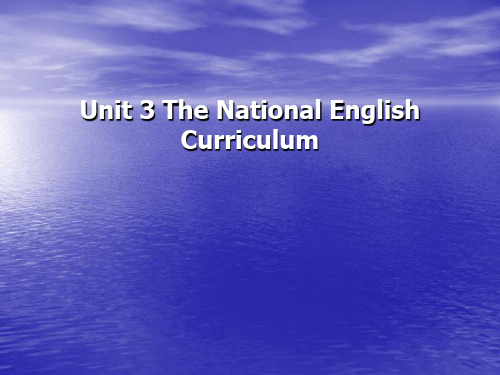
Unit 3 The National English Curriculum
• Objectives:
•l
Get the students to know about the background of
the design of the National English Curriculum.
•l
• Linguistic knowledge: Phonetics;
Vocabulary; Grammar; Functions; Topics
• Language skills: Listening; Speaking;
Reading; Writing
• Cultural awareness: cultural knowledge;
The new curriculum is designed to promote students’ overall language ability, which is composed of five interrelated components, namely, language skills, language knowledge, affects, learning strategies and cultural understanding. Each component is further divided into a few sub-categories. Language teaching is no longer aimed only for developing language skills and knowledge, but expanded to developing learners’ positive attitude, motivation, confidence as well as strategies for life-long learning along with cross-cultural knowledge, awareness and capabilities.
• Objectives:
•l
Get the students to know about the background of
the design of the National English Curriculum.
•l
• Linguistic knowledge: Phonetics;
Vocabulary; Grammar; Functions; Topics
• Language skills: Listening; Speaking;
Reading; Writing
• Cultural awareness: cultural knowledge;
The new curriculum is designed to promote students’ overall language ability, which is composed of five interrelated components, namely, language skills, language knowledge, affects, learning strategies and cultural understanding. Each component is further divided into a few sub-categories. Language teaching is no longer aimed only for developing language skills and knowledge, but expanded to developing learners’ positive attitude, motivation, confidence as well as strategies for life-long learning along with cross-cultural knowledge, awareness and capabilities.
英语教学法PPP模式,TBLT , Five Steps PPT

encourages students to think and analyze.
3. Listening and Reading PPP--to illustrate a single language item. TBL--to provide a more varied exposure to natural
on phase, the language is already familiar) 2. Consciousness PPP--simply to repeat ,manipulate and apply . TBL--to raise students' consciousness by activities and
What ห้องสมุดไป่ตู้s the PPP?
Presentation : Teacher teach a new language item .
Practice: Students apply the new language item.
Production: Students use the new language item. The PPP Teaching focus on the language item that designed before class
activity, role play or task TBL : Strive for accuracy and fluency as learners
prepare to ‘go public’ for the report stage.
E. The task supplies a genuine need to use language to communicate ,and planning and report follow on naturally from the task.
3. Listening and Reading PPP--to illustrate a single language item. TBL--to provide a more varied exposure to natural
on phase, the language is already familiar) 2. Consciousness PPP--simply to repeat ,manipulate and apply . TBL--to raise students' consciousness by activities and
What ห้องสมุดไป่ตู้s the PPP?
Presentation : Teacher teach a new language item .
Practice: Students apply the new language item.
Production: Students use the new language item. The PPP Teaching focus on the language item that designed before class
activity, role play or task TBL : Strive for accuracy and fluency as learners
prepare to ‘go public’ for the report stage.
E. The task supplies a genuine need to use language to communicate ,and planning and report follow on naturally from the task.
英语教学法-34页PPT精品文档

很久很久以前,有一棵又高又大的苹果树。一 位小男孩,天天到树下来,他爬上去摘苹果吃,在 树荫下睡觉。他爱苹果树,苹果树也爱和他一起玩 耍。
• Time went by... the little boy had grown up and he no longer played around the tree every day. One day, the boy came back to the tree and he looked sad. "Come and play with me," the tree asked the boy. "I am no longer a kid, I don't play around trees anymore." The boy replied, "I want toys. I need money to buy them.“ "Sorry, but I don't have money...but you can pick all my apples and sell them. So, you will have money." The boy was so excited. He grabbed all the apples on the tree and left happily. The boy never came back after he
picked the apples. The tree was sad.
• 后来,小男孩长大了,不再天天来玩耍。一天 他又来到树下,很伤心的样子。苹果树要和他 一起玩,男孩说:"不行,我不小了,不能再和 你玩,我要玩具,可是没钱买。"苹果树说:"
• Time went by... the little boy had grown up and he no longer played around the tree every day. One day, the boy came back to the tree and he looked sad. "Come and play with me," the tree asked the boy. "I am no longer a kid, I don't play around trees anymore." The boy replied, "I want toys. I need money to buy them.“ "Sorry, but I don't have money...but you can pick all my apples and sell them. So, you will have money." The boy was so excited. He grabbed all the apples on the tree and left happily. The boy never came back after he
picked the apples. The tree was sad.
• 后来,小男孩长大了,不再天天来玩耍。一天 他又来到树下,很伤心的样子。苹果树要和他 一起玩,男孩说:"不行,我不小了,不能再和 你玩,我要玩具,可是没钱买。"苹果树说:"
英语教学法TBLT.ppt

making a telephone call;
SETTING
PURPOSE
ACTION
TASK
Teacher and Ss Input & output
COMMUNICATIVE
Can you identify the excerise and task?
Role-play a dialogue in the textbook. Read a passage and answer questions. Do a survey to find out the most favorite food in the class. Change sentences into passive voice.
of language for meaningful purposes.
History
1950s: first appeared in the vocational training practices 1975: the Malaysian Communicational Syllabus 1985: the Bangalore Project (Prabhu) 1989: David Nunan offers his definition. 1980s: tasks as SLA research tools (Long and Crookes) 1996:Some of its proponents(e.g. Willis) present it as a logical development of CLT. 1998s:Feez come up the key assumptions of task-based instruction.
TBLT is motivated by a theory of learning The nature of language underlining TBLT
SETTING
PURPOSE
ACTION
TASK
Teacher and Ss Input & output
COMMUNICATIVE
Can you identify the excerise and task?
Role-play a dialogue in the textbook. Read a passage and answer questions. Do a survey to find out the most favorite food in the class. Change sentences into passive voice.
of language for meaningful purposes.
History
1950s: first appeared in the vocational training practices 1975: the Malaysian Communicational Syllabus 1985: the Bangalore Project (Prabhu) 1989: David Nunan offers his definition. 1980s: tasks as SLA research tools (Long and Crookes) 1996:Some of its proponents(e.g. Willis) present it as a logical development of CLT. 1998s:Feez come up the key assumptions of task-based instruction.
TBLT is motivated by a theory of learning The nature of language underlining TBLT
小学英语教学方法PPT教学课件

果能把内容相近、相反或相同的可比性
知识放在一起进行对照、比较,就能帮
助学生把类别性的知识“连接”起来,
使他们在头脑中有一个链条式的记忆锁,
提高小学生进行初步抽象概括思维的能
力。例如在教学Panda这个单词时,可
以就它与学过的器官eye的一个共同属
性———黑白颜色进行归纳总结。这样
教学将关键词Panda、Eye、Black、
过渡。又如在导入Stationeries时,可以
先用汉语告诉学生一个chant“铅笔盒里有
铅笔,铅笔里面有钢笔”,利用学生此
时产生的“?”疑惑感,如此在接下来
的教学中通过展示、教学这三个单词,
使学生恍然大悟,产生一种解疑后的喜
悦感和成就感。
2020/12/10
11
对比导入
对比导入,即是在教师讲授新课时,如
曲导入动物话题的教学;然后再把歌词
相应地替换成“Teddy Dog,Teddy
Rabbit…”达到在一个轻音乐缭绕的氛围
中导入一项教学内容的目的。
2020/12/10
10
悬念导入
恰当的悬念是一种兴奋剂。教师在教学
中给学生设下悬念,能勾起学生强烈的
破疑愿望,激起他们寻根探源的欲望,
从而促使学生迈过“信息沟”实现交际
2020/12/10
8
故事导入
就像每个单元的C部分设置了Story time,以巩
固本单元的内容一样。我们也可以大胆创新,
把它搬家移到一个教学单元的开头。例如对第 四单元的Animals的导入设计。在进行A部分教
学时,教师可以以一个农场主的身份介绍 “Look! I have a rabbit.”……同时还为后面 的song“Old MacDonald”做了铺垫;而在进行 B部分的导入时,教师又可以改扮成一个动物
《小学英语教学法》课件

Student feedback
Collect feedback from students on their learning experience, including the effectiveness of the course in enhancing their English skills and knowledge
Encouraging active learning
promoting student participation in class ions, role playing, and other interactive activities
Assessing student progress
Evaluate one's own delivery of instructions, including language clarity, ability to engage students, and utilization of effective teaching techniques
Detailed description
Summary
Learning language by completing practical tasks, emphasizing the practical application of language and problem-solving abilities.
Summary
Teaching language by simulating real-life scenarios to help students understand and apply language.
Detailed description
Collect feedback from students on their learning experience, including the effectiveness of the course in enhancing their English skills and knowledge
Encouraging active learning
promoting student participation in class ions, role playing, and other interactive activities
Assessing student progress
Evaluate one's own delivery of instructions, including language clarity, ability to engage students, and utilization of effective teaching techniques
Detailed description
Summary
Learning language by completing practical tasks, emphasizing the practical application of language and problem-solving abilities.
Summary
Teaching language by simulating real-life scenarios to help students understand and apply language.
Detailed description
英语教学法ppt课件

11
英语教学法及其相关学科
Байду номын сангаас理学对教学法的影响
1. 19世纪,20世纪初,心理学不发达 翻译法,直接法主导 2. 行为主义心理学- 听说法三个实践 A 桑代克(美)饿猫取食 B 巴甫洛夫 狗实验 C 斯金纳(美)白鼠实验 3. 认知心理学冲击 乔姆斯基语言学校理论生成
12
Homework
的方法创立的。 主张先开始听,然后才学习讲,然后
再学习读写。 教学原则: 外语是教学的语音,使用外语教授外
语。 只教授日常使用的词汇和句子。 听、说同时教。 强调正确的发音和句子语法的准确性。
22
2.4 20世纪西方的外语教学
1. 直接法有其不足之处 2. 英国的情景法建立 代表教材:《新概念英语》 3. 20世纪60年代后的西方外语教学
抄写一篇短文章,要求字迹工整
13
第二章 英语教学法简史
学习简史的目的: 1. 帮助我们了解不同历史阶段出
现过的外语教学法; 2. 了解这些教学方法出现的历史
背景,以及一种教学方法为什么 和怎么样被另一种教学方法所取 代。
14
2.1 古代和中世纪西方的外语 教学
在欧洲,拉丁语作为通用语延续 了几个世纪
16
拉丁语由教学语言变成一门课程, 地位下降
16至18世纪外语教学的特点: 一些学者和教育家对当时语言教
学实践不满并不断进行改革。
17
代表人物:
A 阿斯堪(英):重视古文教学, 以翻译作为主要教学手段
B 蒙田(法):提出用“自然法” 学习外语(去外国学习语言文化)
C 柯米尼亚斯(捷克):17世纪 最有影响的教育家,主张用“直 觉法”教学
5
常用的英语教学方法
英语教学法及其相关学科
Байду номын сангаас理学对教学法的影响
1. 19世纪,20世纪初,心理学不发达 翻译法,直接法主导 2. 行为主义心理学- 听说法三个实践 A 桑代克(美)饿猫取食 B 巴甫洛夫 狗实验 C 斯金纳(美)白鼠实验 3. 认知心理学冲击 乔姆斯基语言学校理论生成
12
Homework
的方法创立的。 主张先开始听,然后才学习讲,然后
再学习读写。 教学原则: 外语是教学的语音,使用外语教授外
语。 只教授日常使用的词汇和句子。 听、说同时教。 强调正确的发音和句子语法的准确性。
22
2.4 20世纪西方的外语教学
1. 直接法有其不足之处 2. 英国的情景法建立 代表教材:《新概念英语》 3. 20世纪60年代后的西方外语教学
抄写一篇短文章,要求字迹工整
13
第二章 英语教学法简史
学习简史的目的: 1. 帮助我们了解不同历史阶段出
现过的外语教学法; 2. 了解这些教学方法出现的历史
背景,以及一种教学方法为什么 和怎么样被另一种教学方法所取 代。
14
2.1 古代和中世纪西方的外语 教学
在欧洲,拉丁语作为通用语延续 了几个世纪
16
拉丁语由教学语言变成一门课程, 地位下降
16至18世纪外语教学的特点: 一些学者和教育家对当时语言教
学实践不满并不断进行改革。
17
代表人物:
A 阿斯堪(英):重视古文教学, 以翻译作为主要教学手段
B 蒙田(法):提出用“自然法” 学习外语(去外国学习语言文化)
C 柯米尼亚斯(捷克):17世纪 最有影响的教育家,主张用“直 觉法”教学
5
常用的英语教学方法
- 1、下载文档前请自行甄别文档内容的完整性,平台不提供额外的编辑、内容补充、找答案等附加服务。
- 2、"仅部分预览"的文档,不可在线预览部分如存在完整性等问题,可反馈申请退款(可完整预览的文档不适用该条件!)。
- 3、如文档侵犯您的权益,请联系客服反馈,我们会尽快为您处理(人工客服工作时间:9:00-18:30)。
4.The teaching method of game teaching
features:
Game plays features are strong. It's fun, let children in relaxing fun in learning English, feel fully the fun activities, experience the joy of learning.
4.The teaching method of game teaching
Organize English activities in the form of the game, is very accord with the age characteristics , making children have fun in the English game activities, learn more easily.
2.Grammar-Translation Method
Advantages:
• It can help students to have a better understanding of the meaning of words and sentences, the use of the grammar. • It can foster students’ ability of reading comprehension and writing correct sentences and cultivate their ability of having a test.
4.The teaching method of game teaching
It means teachers use the form of game to stimulate children's study interest. To organize children to do English study activities. To train children's pronunciation. To enrich children's vocabulary and sentences.
1.A Functional-Notional Approach
Practice:
The course is relatively short, students have no time to go into the complexities of the grammar. Students will need a more thorough grounding in English grammar and will have to learn a lot of vocabulary. Students will be taught by means of situation and useful communicative functions.
2.Grammar-Translation Method
Features:
• It emphasized the teaching of the foreign language grammar. • Language skills are emphasized reading and writing but little attention is paid to speaking and listening. • The words and sentences are the basis of language teaching and learning. • Students would be guided by teachers.
1. A Functional-Notional Approach
Content:Definition Features Practice Advantages Disadvantages
1.A Functional-Notional Approach
Definition:
Language is used to realize communicative functions and convey meanings. Notion– what ideas and meanings people want to say. Function– what you do with the language when you interact with people.
1.A Functional-Notional Approach
Advantages:
This method of language teaching is categorized along with others under the rubric of a communicative approach. The method stresses a means of organizing a language syllabus. The emphasis is on breaking down the global concept of language into units of analysis in terms of communicative situations in which they are used.
3.Parallels Between First And Second Language Learning
Definition:
1.Krashen克拉申defined the term language acquisition: gaining use of a language without any conscious learning. 2. Language acquisition refers to the way we acquire our mother tongue without consciously or formally learning it. Learning a language requires some formal training and conscious effort.
Content:
• • • • • Definition features Practices Advantages Disadvantages
2.Grammar-Translation Method
Definition:
• The Grammar-Translation Method is a method of foreign of second language teaching which uses translation and grammar study as the main teaching and learning activities.
2.Grammar-Translation Method
Disadvantages:
• Students would lose the interest of learning foreign language gradually. • Students cannot use the language in the real life.
1.A Functional-Notional Approach
Disadvantages
• 1.Students cannot produce the correct sentences. • 2.Students cannot pass the test easily.
2.Grammar-Translation Method
3.Parallels Between First And Second Language Learning
Audio-Lingual Method听说教学法
------ by behaviorist psychologists
Definition This method gives the learner stimuli in the form of prompts, and praises the correct response or punishes an incorrect response, until the right one was given.
1.A tional Approach
Features:
The forms of language are not important. The meanings of language are important. The purposes (functions) of using the language and the meanings (notions) expressed through the language rather than grammatical forms.
3.Parallels Between First And Second Language Learning
4.The teaching method of game teaching
●Definition ●Features ●Practice ●Advantages ●Disadvantages
3.Parallels Between First And Second Language Learning
Conclusion
1. Language is not learnt merely by copying what is said or written. Learners have to be given the chance to experiment with language. 2. There are differences between learning the first and a second language.
